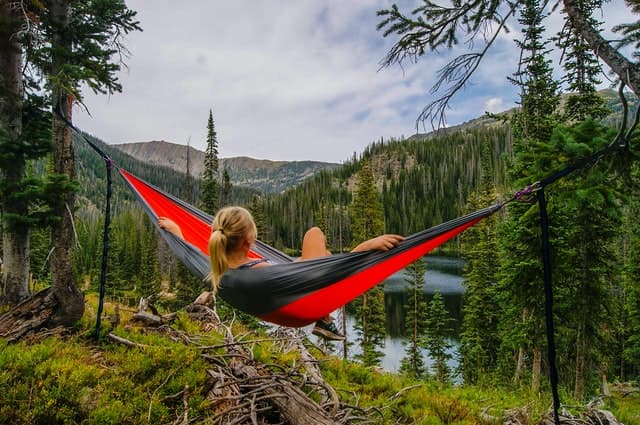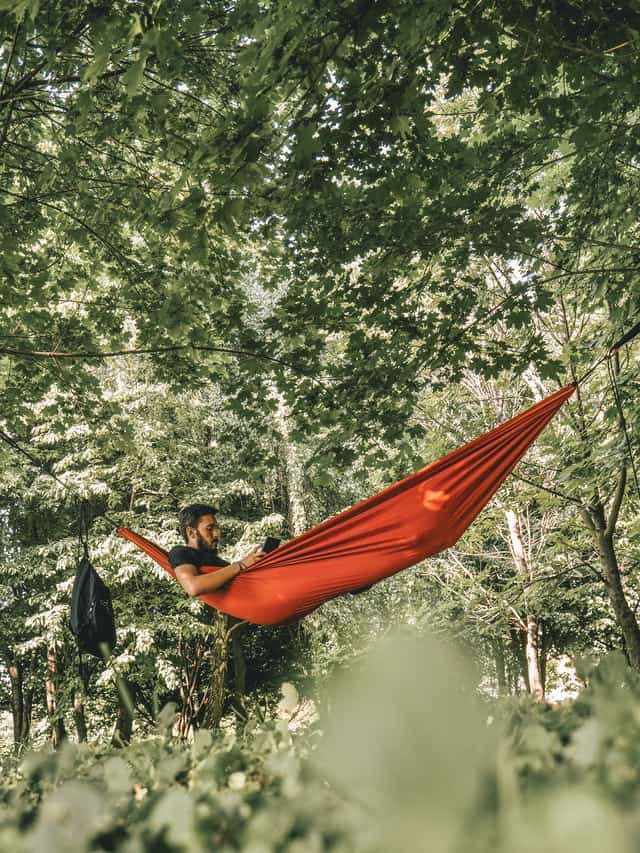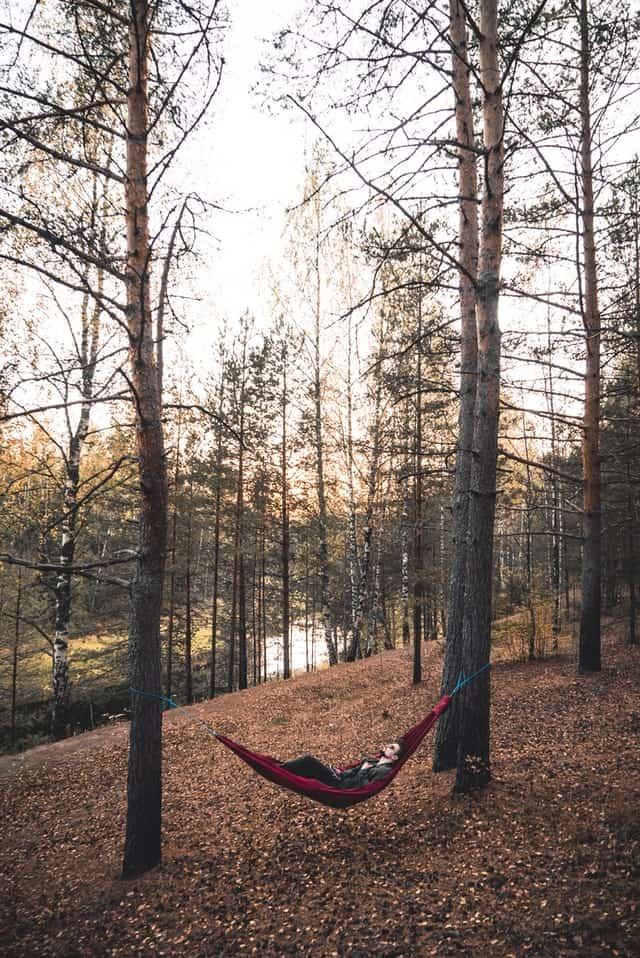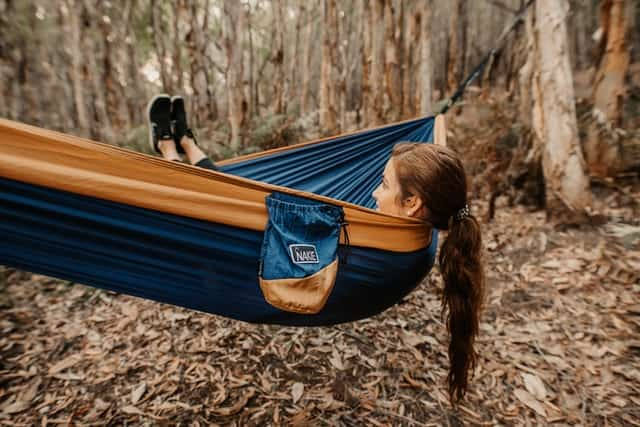Hammock camping is a new activity for many, but it’s quickly becoming a favorite of outdoor enthusiasts. If you’re considering hammock camping as an option, this post will provide everything you need to know about what it entails and how to get started. I’ll cover the basics like why people choose hammocks over tents or cots, how to find the right materials for your first outing, and even some tips for beginners!
But first let’s start with the basics for complete newbies to the space of hammock camping. So what is hammock camping? It’s basically the act of sleeping in a hammock instead of other common camping methods like tents or cots. There are many benefits to hammock camping, including how much easier it is on your back and general body as you sleep since there’s no pressure points from any kind of surface below you.
Many people choose this method because they want to truly experience the outdoors by sleeping right outside in the elements all night long. There’s not much more comfortable than sleeping in a hammock either.
The best part of hammock camping though is the many ways to set it up. You can hang your hammock from a tree, put in on top of an overhang or even inside a portable hammock stand if you’re feeling fancy. There are also plenty of different types out there for any skill level and budget range! I’ll get into that in the last section so if you are looking for some hammock camping must-haves, scroll to the bottom of the blog.

How to camp in a hammock
The basics of camping in a hammock include choosing when you want to go, which includes planning around the weather. Specifically, you’ll want to pay attention to the temperatures of your campsite overnight.
Following that, you’ll want to learn how to properly set up your sleeping area. Some things to consider are:
- any insects or wildlife that can become a problem?
- if you’re using a tarp, how high should you tie it up
- How much space will my hammock take up in relation to where the trees are located?
- Do I have enough gear or am I missing anything important that would make this camp more comfortable and safe for me?
I’ll also share how to set up your tarp and some tips for beginners on how to make sure you’re comfortable at night.

How cold is too cold for hammock camping?
The temperature that is too cold for hammock camping is about 40°F or lower. However, that is not the full story. You can certainly camp under these temperatures with the right equipment.
Some camping equipment that can make your overnight stay in a hammock warmer and more comfortable include a sleeping bag with a temperature rating that is adequate for your expected temperatures. with a tarp so that it’s wind- and water-resistant
Setting up your hammock
Setting up your hammock is really easy by following these steps.
The distance between your two desired trees is the most important part of picking out a hammock for it. If you’re looking to buy one, make sure that they are within 10-15 feet away from each other so that when you go into fetal position, there’s enough room in the middle!

You can also buy a hammock stand, which is typically the easiest way to set up your hammock. It’s not too expensive and they’re very easy to find online or at an outdoor gear store near you.
After throwing the rope around a tree trunk or branches, insert one end of the non-looped section into the loop on the opposite side and tighten until snug. If you’re using two trees for tethering your hammock, repeat these steps with another cord from an unused portion of this same set to make sure it doesn’t sag onto ground level. Be sure that when tying up ropes between 2 trees in order to hang your hammock is done at shoulder height so you have enough space inside once finished!
Parts of a sleeping bag hammock
A camp pillow is a must-have and something we can’t recommend enough. A soft pillow will help with neck pain support.
Most hammocks meant for sleeping in overnight will include the following:
Sleeping Pad
Whether you’re in a tent or a hammock, the underside of your lofty sleeping bag in your hammock gets compressed and loses its insulation value when you lie on it. In order to solve this problem while still being comfortable, there are two options that can be tried- both an inflated air mattress or foam mat will help provide comfort for those trying out these new ways of camping! If one is feeling more adventurous they may also choose to cut their closed cell foam mat into pieces just large enough for each individual person and then place them inside the hammocks underneath where they sleep (though if doing so make sure not let cuts reach through fabric).
Tarp
If you’re planning on hanging your hammock in a remote area, it’s always best to be prepared for the worst. That means packing a tarp and some rope with you just in case. A well-placed tarp will protect your whole body from wind, rain or snow – not only does this keep things dry but also helps prevent injury by allowing any moisture to drip off before landing on fragile skin!
Mosquito or Bug Net
If you’re a hammock camper, then we have more good news for you! You don’t need to bring along your own bug net. Hammocks provide protection against pesky bugs that plague many during the summer months with their mosquito nets and fly screens. If there are any gaps in coverage, though, it’s all over and you’ll be swatting away mosquitoes instead of sleeping soundly through the night in your cozy hammock bedding (and who wants to do that?).
Underquilt
You’ll also want to consider getting a mosquito net, which can be hung over your hammock to provide a protective barrier. If you are in an area that has a lot of insects, you’ll definitely want to consider a net.
Suspension
The suspension system gives your hammock the strength to hold up and is one of its most essential parts. The best suspensions are adjustable, so that you can adjust it after suspending on nearby trees with whoopie slings or daisy chain straps – which are two common types of adjustments.
Whoopie slings are a great way to get your hammock set up quickly and easily. All you have to do is find two trees, attach one end of the sling around each tree’s strap webbing with an adjustable loop on it that attaches back onto the straps in front or behind your hammock depending on which side you want them on. The other side goes over the top edge of your hammock so all you need is enough slack for either person sitting inside! It couldn’t be simpler than this ingenious design helps make camping more fun by making setup easy as pie!
Instead of rope, most people use a piece of non-stretch webbing to attach their hammock. This wider webbing is less likely to damage the tree bark and can be required by many campgrounds or state parks. A straight piece will cost you some money but it may not work as well for your needs depending on how long you want your attachment from the ground up into trees. Non-straight pieces are also available that make finding an anchor point easier than before with this material if done properly because they have D rings at each end instead of just one like regular slackline would come with so attaching either way is possible when using more complicated knots such as carabiners.
Daisy chain straps are much more comfortable and easier to use than a whoopie sling, but they can be pricey. They hold the hammock in place with loops that you attach it to using carabiners.

Hang In There
Hammocks are becoming increasingly popular for camping, backpacking, and just lounging around during the summer months. They’re perfect for people who don’t want sleeping on the ground or
